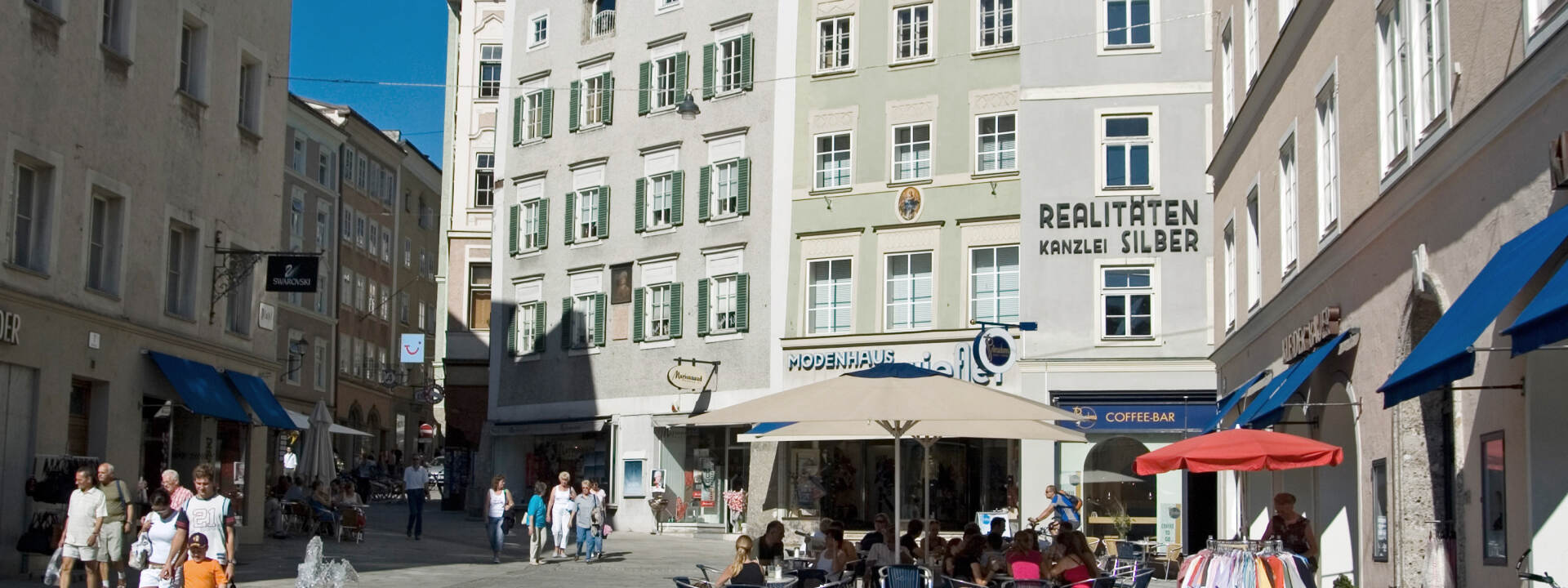
Linzergasse Salzburg
Stroll through the Linzergasse during a shopping tour
Many of the quaint, old houses of the Linzergasse can trace their chronicles back to the 14th and 15th centuries and still bear witness to the efficient and industrious burghers of yesteryear. The devastating city fire of 1818, causing extensive damage to the right bank of the Salzach River, did not spare the Linzergasse but the wounds have meanwhile healed and the charming burgher houses - lovingly renovated - once again border this beautiful old district in Mozart's city.
The Linzergasse with its handicrafts and old shops, its countless restaurants and hostels and its unmatched local flair has always been the counterpart of its "Salzburger" sister, the elegant, international Getreidegasse on the other side of the river. For many centuries, those who needed a turner, a draper or butcher, a gunsmith or chain maker, a clockmaker, cooper or art metal worker, an apothecary and barber-surgeon, a gingerbread-maker and wax-chandler or even a bell-founder were at the right address in the Linzergasse. Coming from the "Platzl" at the Staatsbrücke, one's glance falls upon house number 3, where the natural scientist Theophratus Bombastus von Hohenheim, also called paracelsus, lived from 1540 to 1541.
The Engel Apothecary's Shop is located in house number 7, whose most prominant apprentice was certainly the poet Georg Trakl born in Salzburg in 1887. Right next-door in Linzergasse house number 9, the Hotel Gablerbräu, a plaque commemorates the great singer, Richard Mayr, the unforgetable "Ox of Lerchenau" in Richard Strauss' opera "Der Rosenkavalier".
Upon crossing to the other side of the Linzergasse, an impressive gate and stairway entices one to an introspective ascent of the Kapuzinerberg over an old crossroad; the slightly exerting climb up to the Capuchin Monastery is rewarded by a wonderful view of the beautiful Old City at the foot of Hohensalzburg Fortress on the opposite side of the river. The well-preserved city walls dating back to the Thirty Years' War bear witness to the principality's excellent fortification during those militant times.
Just a few steps down the Linzergasse is Kirche St. Sebastian and the impressive Sebastian's Cemetery, built around 1600 by Prince Archbishop Wolf Dietrich von Raitenau in the style of an Italian campo santo, not having surrendered any of its centuries-old dignity and silent beauty in spite of the turmoil of past and present times. The cemetery contains the tomb of the physician Paracelsus.
The magnificent mausoleum for Archbishop Wolf Dietrich von Raitenau, probably the most prominent of Salzburg's Baroque princes, in the center of the cemetery is a past and present tourist attraction. The music lover will find the final resting-places of Mozart's father Leopold and Wolfgang's wife Constanze as well as her second husband, Georg Nikolas von Nissen and her aunt Genovefa von Weber, mother of the composer Carl Maria von Weber, enroute to the mausoleum.
Prominent Salzburg burghers and merchants' families were buried under the magnificent arcades of the cemetery and a walk across the silent churchyard is like browsing through the book of Salzburg's history over the centuries. The Church of St. Sebastian, renovated with a great feeling for the arts, contains a magnificent wrought iron gate made by Philipp Hinterseer and a high altar bearing a statue of the Madonna by Hans Waldburger dating back to 1611.
